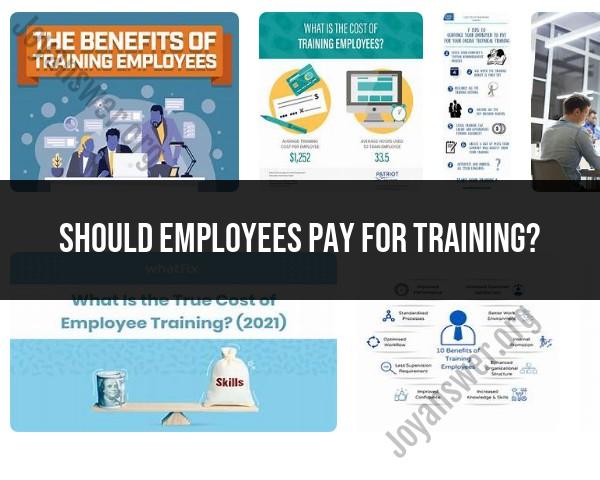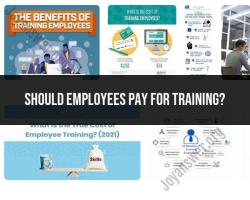Should employees pay for training?
The question of whether employees should pay for training is contingent on various factors, including industry norms, organizational policies, and the nature of the training. There is no one-size-fits-all answer, and different organizations may adopt different approaches based on their priorities and financial considerations. Here are some perspectives to consider:
Employer-Paid Training:
- Investment in Employees: Many employers view training as an investment in their workforce. By providing training opportunities, organizations aim to enhance the skills and knowledge of their employees, making them more effective in their current roles and better prepared for future responsibilities.
- Retention and Engagement: Employer-funded training programs can contribute to higher levels of employee retention and job satisfaction. Employees may feel valued and more engaged when they see that their employer is committed to their professional development.
Shared Responsibility:
- Cost-Sharing Arrangements: Some organizations implement cost-sharing arrangements where both the employer and the employee contribute to training expenses. This approach recognizes the mutual benefits of training and encourages a sense of shared responsibility.
- Reimbursement Policies: Employers may have reimbursement policies in place, where they reimburse employees for approved training expenses upon successful completion of the program. This allows employees to invest in their development while knowing they will be reimbursed.
Employee-Paid Training:
- Career Advancement: In some cases, employees may voluntarily choose to invest in their own training for the purpose of career advancement. This could involve pursuing additional certifications, attending workshops, or enrolling in courses that align with their career goals.
- Specialized Training: In industries or professions where employees are expected to continually update their skills, some individuals may take the initiative to invest in specialized training independently of their employers.
Industry Standards:
- Common Practices: The approach to training costs can vary by industry. In some industries, it might be more common for employers to fully cover training expenses, while in others, employees may be expected to cover some or all of the costs.
Financial Considerations:
- Organizational Budgets: The financial health of an organization may influence its ability to cover training costs. Smaller businesses with limited budgets may find it challenging to fully fund extensive training programs for all employees.
Ultimately, the decision regarding who pays for training is a matter of organizational policy, culture, and strategic priorities. It's important for both employers and employees to communicate openly about training expectations and costs. Clear policies, transparent communication, and a shared commitment to professional development can contribute to a positive training experience for all parties involved. Additionally, legal and regulatory considerations may influence whether certain types of training must be provided by the employer at no cost to the employee.
Navigating the Maze of Training Costs: Who Pays?
Whether employees chip in for training depends on a complex interplay of factors, legal regulations, and organizational policies. Here's a breakdown to help you navigate:
1. Commonality of employee-funded training:
It depends on the training type and organizational context.
- Mandatory training: Usually, employers cover it. If required for job performance and mandated by law, like safety training, employers have a legal obligation to bear the cost.
- Voluntary training for job advancement: Employers may share or cover the cost, especially if beneficial to their operations.
- Professional development not directly related to the current job: Employees often contribute financially, particularly for high-cost programs or those unrelated to their immediate job tasks.
2. Considerations for employee training payment:
- Legality: Employers must comply with labor laws regarding minimum wage and overtime if training hours count as work time.
- Cost-benefit analysis: Organizations weigh the financial investment against the return on investment from a trained workforce.
- Employee motivation: Sharing costs can incentivize employees who genuinely value the training and plan to stay with the company.
- Equity and access: Organizations should ensure training affordability for all employees to avoid disadvantaging lower-income workers.
3. Usual ways organizations handle training expenses:
- Full employer funding: Common for mandatory training and for programs deemed crucial to organizational success.
- Shared cost model: Employer and employee split the cost based on factors like training value and potential career advancement benefits.
- Tuition reimbursement: Employees pay upfront, get reimbursed upon successful completion, or have part of the cost reimbursed based on performance or continued employment.
- Scholarships or grants: Some organizations offer internal or external funding opportunities for employees pursuing specific training.
4. Potential implications of employees paying for training:
- Financial burden: Can discourage participation, especially for low-wage workers, and exacerbate income inequality.
- Reduced access to development: May limit upward mobility and talent retention if valuable training is unaffordable to some employees.
- Resentment and demotivation: Employees might feel exploited if required to pay for training that primarily benefits the employer.
5. Instances where employee contribution can be beneficial:
- Increased commitment and ownership: Sharing costs can motivate employees to fully engage with the training and apply their newfound skills.
- Greater value perception: Contributing financially can make employees feel more invested in the training and appreciate its value.
- Sustainable training programs: Employee cost-sharing can help organizations offer continuous development opportunities without draining resources.
Remember, there's no one-size-fits-all approach to training costs. Organizations should strive for transparent and equitable policies that balance employee development with financial feasibility, considering legal requirements and the specific training context.



